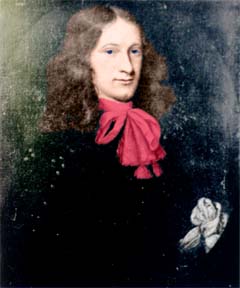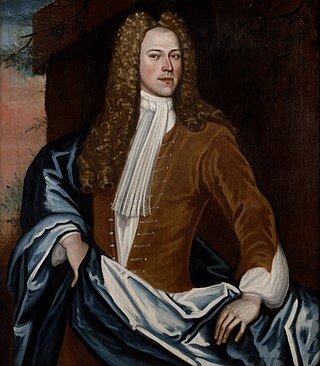
Robert Livingston the Elder was a Scottish-born merchant and government official in the Province of New York. He was granted a patent to 160,000 acres of land along the Hudson River, becoming the first lord of Livingston Manor.

Thomas Dongan, 2nd Earl of Limerick, was a member of the Irish Parliament, Royalist military officer during the English Civil War, and Governor of the Province of New York. He is noted for having called the first representative legislature in New York, and for granting the province's Charter of Liberties. His negotiations and subsequent alliance with the Iroquois Indian Confederacy brought a lasting security from the French and their hostile Indian allies.

Lieutenant-General Francis Nicholson was a British Army general and colonial official who served as the governor of South Carolina from 1721 to 1725. He previously was the Governor of Nova Scotia from 1712 to 1715, the Governor of Virginia from 1698 to 1705, the Governor of Maryland from 1694 to 1698, the Lieutenant Governor of Virginia from 1690 to 1692, and the Lieutenant Governor of the Dominion of New England from 1688 to 1689.
James De Lancey served as chief justice, lieutenant governor, and acting colonial governor of the Province of New York.

The Frame of Government of Pennsylvania was a proto-constitution for the Province of Pennsylvania, a proprietary colony granted to William Penn by Charles II of England. The Frame of Government has lasting historical importance as an important step in the development of American and world democracy.
Spencer Phips was a government official in the Province of Massachusetts Bay. Born Spencer Bennett, he was adopted by Massachusetts Governor Sir William Phips, his uncle by marriage, whose name he legally took. Phips served for many years in the provincial assembly, and on the governor's council, before receiving an appointment as lieutenant governor in 1732, a post he held until his death. He was twice formally acting governor.
William "Tangier" Smith was a governor of Tangier, on the coast of Morocco, and an early settler of New York who owned more than 50 miles (80 km) of Atlantic Ocean waterfront property in central Long Island in New York State, in what is called the Manor of St. George. In 1701, he was Acting Governor of New York.

Francis Howard, 5th Baron Howard of Effingham was a member of the Howard family, descended from noted naval commander Lord High Admiral Howard, and a Crown Governor of Virginia (1683-1692).
The Charter of Liberties and Privileges was an act passed by the New York General Assembly during its first session in 1683 that laid out the political organization of the colony, set up the procedures for election to the assembly, created 12 counties, and guaranteed certain individual rights for the colonists. The colony operated under the Charter until May 1686 when Thomas Dongan, the governor of New York, received instructions from King James II that New York would be assimilated into the Dominion of New England. After the Glorious Revolution William III and Mary II appointed a new governor, who convened the colonial assembly on April 5, 1691.

The Governor's Council, also known as the Privy Council and Council of State, was the upper house of the legislature of the Colony of Virginia. It also served as an advisory body to the royal governor and as the highest judicial body in the colony. Beginning in the 1630s, its 12 members were appointed by the British sovereign. After Virginia declared its independence from Great Britain in 1776, members were appointed by the General Assembly, and most of the their powers were redistributed to the newly-formed Senate of Virginia and the state's judiciary. The Council was formally abolished after delegates to the 1850 Virginia constitutional convention voted to enact what became known as the "Reform Constitution," which vested many of its remaining functions in the popularly-elected offices of Governor, Lieutenant Governor, and Attorney General.
Major Anthony Brockholls was an English born Commander-in-Chief (1677–78) and then acting Governor (1681–82) of New York.
Captain Andrew Bowne was an American colonial politician and jurist, who served in various capacities in both New York and New Jersey.

Wilhelmus Hendricksen Beekman – also known as William Beekman and Willem Beekman – was a Dutch immigrant to America who came to New Amsterdam from the Netherlands in the same vessel with Director-General and later Governor Peter Stuyvesant.
William Pinhorne was an American colonial politician and jurist, who served in various capacities in both New York and New Jersey.

Johannes de Peyster or Johannes de Peyster III was the Mayor of Albany, New York three times between 1729 and 1742.

The General Assembly of New York, commonly known internationally as the New York General Assembly, and domestically simply as General Assembly, was the supreme legislative body of the Province of New York during its period of proprietal colonialship and the legislative body of the Province during its period as a crown colony. It was the representative governing body in New York until April 3, 1775, when the Assembly disbanded after the outbreak of the Revolutionary War.
James Graham was a Scottish born colonial American politician who served as the Speaker of the New York General Assembly.
David Jamison was a Scottish-American lawyer, judge, and provincial official in the Province of New York and New Jersey.








